NE'ILAH:
The last of the five services held on the Day of Atonement. The earliest mention of it is in the Mishnah (Ta'an. 26a), where it is said: "On three occasions the priests pronounce the benediction four times in the day, namely, at the morning, special [Musaf], and afternoon sacrifices and at the closing of the gates" ("Ne'ilat She'arim"). These three occasions are the Day of Atonement, other fast-days, and the days of "ma'amad" (local celebrations held in the country towns simultaneously with offerings brought in the Temple by delegates from them; see
Another discussion arose, on the meaning of the word itself. R. Johanan held that "Ne'ilah" meant the closing of the gates of the Temple, while Abba claimed that it meant the closing of the gates of heaven (Yer. Ta'an. 7c). Both the Sephardic and the Ashkenazic rituals express the latter idea in their anthems; the Ashkenazic saying: "Open for us the gate at the time of the closing of the gates," and the Sephardic still more clearly: "At the time of the closing of the heavenly gates forgive our iniquities."
History of the Service.It would seem that R. Johanan's interpretation is correct. In the Temple at Jerusalem the priests pronounced the benediction at every sacrificial service. On especially solemn occasions they pronouncedthe benediction a second time, when the gates were to be closed and the last worshipers dismissed. Such an occasion was the Day of Atonement. After the destruction of the Temple, and especially after the Bar Kokba rebellion, when the synagogal service was modeled strictly after that of the Temple, the custom of pronouncing a final benediction at the end of the service was introduced. This benediction seems to have been preceded by another confession of sin. Rab, who had a decisive influence on the crystallization of the ritual (Weiss, "Dor," iii. 157), demanded that a new Tefillah be added to the four of the other holy days; and his opinion prevailed.
Owing to the fact that the Talmud quotes prayers only by the opening words, it is difficult to decide how the present Ne'ilah prayer, which differs considerably in the various rituals, was developed. From the statement of Samuel (Yoma 67b) it would appear that the oldest portion of the Ne'ilah service is the confession of sins, beginning with the above-cited words, "What are we? What is our life?" The passage following it, beginning with the words, "Thou hast distinguished man from the beginning," and dwelling on the power of repentance, is also old, inasmuch as it is found in both rituals, the Sephardic as well as the Ashkenazic, while the introductory passage in the latter, beginning with the words, "Thou holdest out a hand to the transgressors," etc., is much later, though it is met with as early as the thirteenth century. A noteworthy feature of this passage, and to some extent of the whole Ne'ilah service, is the emphasis laid on repentance, while fasting, as well as the expectation of seeing the sacrificial cult revived, is passed over in silence. Throughout the service the word  ("seal us") takes the place of
("seal us") takes the place of  ("inscribe us" [in the book of happy life]), which is employed from Rosh haShanah in all services up to the Ne'ilah.
("inscribe us" [in the book of happy life]), which is employed from Rosh haShanah in all services up to the Ne'ilah.
The piyyuṭim and seliḥot of the Ne'ilah service are of comparatively late origin. Evidently they merely served the purpose of prolonging the service, which had to begin before twilight, until nightfall. Thus there is found in both the German and the Polish rituals a potpourri of various hymns, different in each case. Three anthems in the Ashkenazic ritual begin with the words "Father," "Son," and "Nature." At the end of the service the reader and congregation loudly proclaim seven times "The Lord is God" (this profession of faith being called "Shemot" = "sacred names"), evidently recalling Elijah's invocation on Carmel (I Kings xviii. 39). This custom dates from the thirteenth century. Later sources mention two other passages, "Shema' Yisrael" and "Blessed be the name of His glorious kingdom for ever and aye"; the former to be recited once, the latter three times. These formulas have become invested with a special solemnity, since they are customarily employed in the chamber of the dying. The Ḳaddish and a blast on the shofar conclude the service. It is customary to have the Ne'ilah recited by the rabbi or by a prominent member of the community.
- Yoma 67b;
- Yer. Yoma 7c;
- Maimonides, Yad, Teshubah, ii. 7;
- idem, Tefillah, i. 7-8, iii. 6, xiv. 1;
- Ṭur Oraḥ Ḥayyim, 624;
- Shulḥan 'Aruk, Orah Ḥayyim;
- Baer, in his commentary to the prayer-book 'Abodat Yisrael, Rödelheim, 1868;
- Heidenheim, in his commentary on the Maḥzor.
The traditional intonations of the Ne'ilah are well calculated to excite the emotions of the worshiper. The prevailing chants and melodies are those which characterize the Days of Penitence generally (see Ḳerobot; Music, Synagogal;
As a complete compilation, the melody took shape rather later than the other prayer-motives and melody-types, which were already definite in the medieval period (see Music, Synagogal). Its opening and closing phrases are direct quotations, the first (as far as A in the accompanying transcription) derived from the beginning of the "reshut" and versicle theme for the morning of the Day of Atonement (see Ḳerobot), and the last (commencing at D in the transcription) from the end of the prayer-motive (see Mi Kamokah; Music, Synagogal) of the evening preceding, or "Kol Nidre" service. Prefaced to this closing phrase is an ancient Oriental figure (between B and C in the transcription) occurring elsewhere in the traditional melodies (see Geshem; Mizmor Shir). The intermediate passages, of which the German version is probably the more original, are mere connecting phrases imitated from other passages in the penitential music, but successfully binding the whole in a homogeneous melody.
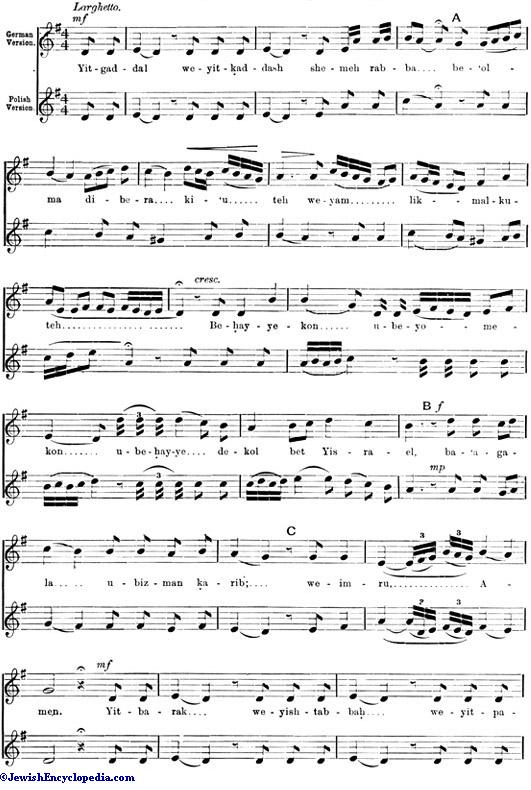
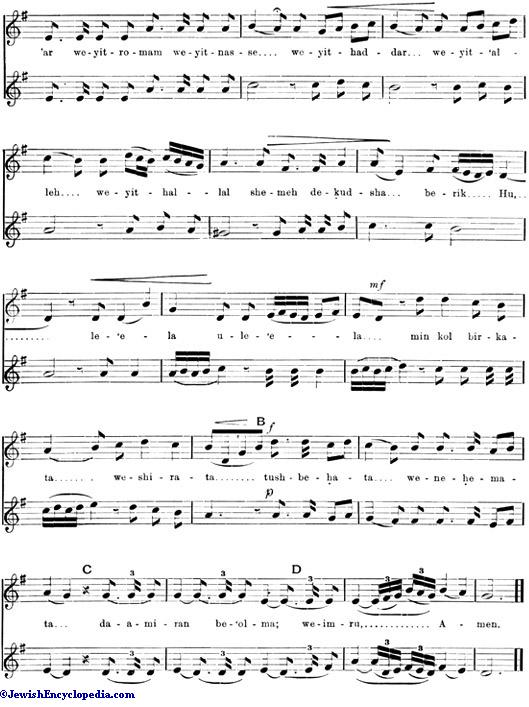
Several of the sections quoted from propitiatory poems are accompanied by the tunes for these hymns when forming part of the penitential prayers on the previous days (see Adonai, Adonai; Bemoẓa'e; Ḳerobot;
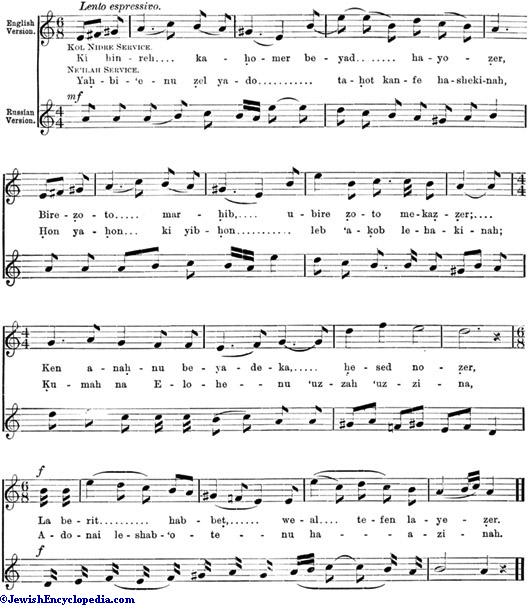


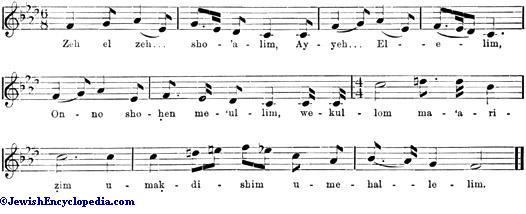
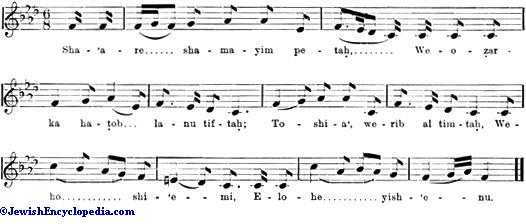
As the service nears its climax, the melodies become severer in tone and broader in expression. This is especially marked in the antiphonal responses of Abinu Malkenu and in the solemn profession of the Shemot. Here, however, as in the earlier portion of the service, the strains characteristically associated with the seasón of penitence are often again utilized. The short concluding sevenfold declaration is then chanted to the intonation already given under Adonai Melek (especially version C). The Shema', with its associated sentence from the Temple service (see 'Abodah), is at least recited by the cantor if not repeated in the tumultuous response of the congregants, in the noble chant to which the Scriptural verse enshrining this declaration of the Unity is traditionally uttered when the Scroll of the Law is displayed as it is taken from the Ark in the New-Year and Atonement services. The verse was originally rendered to the tune designated by its Accents, in the form of Cantillation which was special to these days; and this derivation is still clear under the more melodic form which the rendering afterward took, developing eventually far beyond the original. The melody, by the ingenuity of the Paris cantor Naumbourg, has also been impressively adapted for the successive line of text, on the model of the strain quoted above from the evening service of Atonement.
Sephardic Order and Melodies.

In the Sephardic rite the Ne'ilah differs from the use of the Ashkenazim in the medieval hymns introduced into the public recitation. The traditional intonations lack the haunting tenderness characterizing those of the northern use; and they are much more obviously identical with those of the other Atonement services of the rite (see
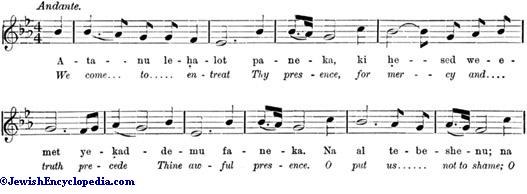
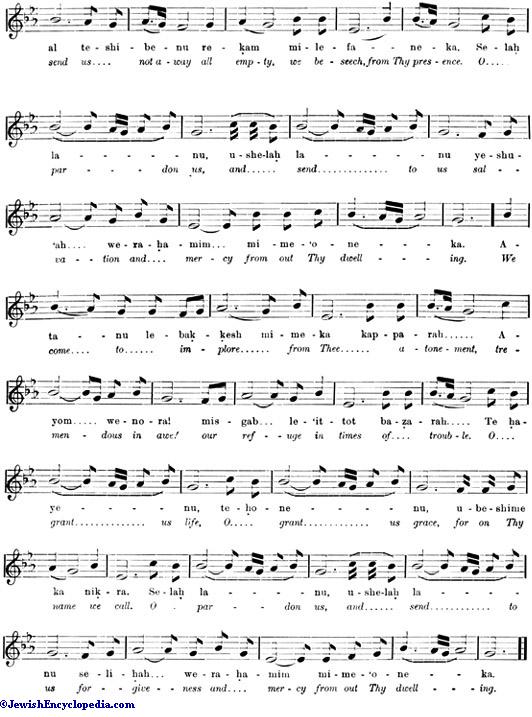
Among the Atonement services in the southern use the Profession of Faith is not so special to the Ne'ilah as in the northern use. In the seliḥot of each of the other four services of the day, officiant and congregation have already reverentially sung the Shema' with its Temple response and the words "The Lord, He is God," the latter in the double form in which it originally occurs in I Kings xviii. 39.In the preceding four services of the day, however, these utterances were associated with a short hymn of Ḳaliric form (comp. Ḳerobot). In the Ne'ilah they are proclaimed by themselves in the midst of the closing Ḳaddish, first by the officiant and then by the congregation, the double verse being seven times reiterated, and all being immediately followed by a single complete series of the Shofar calls, instead of the weirdly solitary call which is heard in the northern ritual.
- Dembitz, Jewish Services in Synagogue and Home. The various melodies of the Ne'ilah are given by A. Baer, Ba'al Tefillah (Der Praktische Vorbeter), Nos. 1466-1488, Göteborg, 1877, Frankfort-on-the-Main, 1883;
- Cohen and Davis, Voice of Prayer and Praise, Nos. 278-289, London, 1899;
- D. Nowakowsky, Schlussgehet für Jom-Kippur, Odessa, 1895;
- Jessurun, Traditional Tunes, in Book of Prayer of the Spanish and Portuguese Jews, London, 1904.








